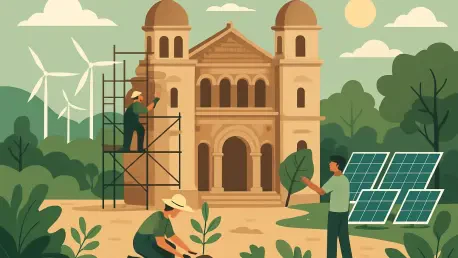I’m thrilled to sit down with Luca Calaraili, a renowned expert in construction, design, and architecture, whose passion for innovative technology has made significant waves in the industry. With a deep understanding of heritage conservation and sustainable building practices, Luca offers invaluable insights into balancing the preservation of historic treasures with modern environmental goals. Today, we’ll explore how his expertise aligns with ambitious sustainability targets, the unique challenges of working on historic estates, and the strategies for ensuring these cherished sites remain accessible for future generations. Join us as we dive into a conversation about protecting our past while building a greener future.
Can you share your perspective on the importance of supporting conservation charities in achieving their sustainability goals?
Absolutely. Conservation charities are stewards of our cultural and historical legacy, managing some of the most iconic and irreplaceable sites. Supporting their sustainability goals means ensuring these treasures endure for future generations while adapting to pressing environmental challenges. It’s about finding harmony between preserving the past and embracing modern needs like energy efficiency and climate resilience. My role often involves providing technical expertise to assess structures, recommend low-impact repairs, and integrate sustainable solutions that don’t compromise historical integrity.
What specific services or approaches do you focus on when working with organizations managing historic properties?
We typically offer a range of services tailored to the unique needs of historic properties, including detailed building surveys, contract administration, and project management. A key focus is on conservation repairs and retrofit upgrades that enhance energy efficiency while maintaining the site’s character. We also prioritize accessibility improvements and infrastructure updates to ensure safety and functionality. Every approach is customized, balancing modern standards with the delicate nature of heritage assets.
How do you balance the preservation of historic sites with the push for modern sustainability standards?
It’s a delicate dance. We start by deeply understanding the historical significance of a site—its materials, construction methods, and cultural value. Then, we layer in sustainability through subtle interventions, like using eco-friendly insulation or renewable energy systems that don’t disrupt the aesthetic or structural integrity. The goal is to enhance performance—think reduced carbon emissions—without erasing the story the building tells. It often requires creative problem-solving and close collaboration with conservation experts.
What unique skills or experiences do you think are crucial for tackling projects involving historic mansions, castles, and gardens?
Working on historic properties demands a blend of technical know-how and a reverence for history. You need a solid background in traditional construction techniques—understanding how lime mortar or ancient timber behaves, for instance. My experience with various heritage projects has taught me the importance of meticulous documentation and research to inform decisions. Equally vital is an ability to adapt modern tools, like digital modeling, to analyze and preserve these structures without invasive methods. It’s about respecting the past while applying today’s innovation.
How do you approach the challenge of improving sustainability across a vast and diverse portfolio of historic buildings and structures?
With a portfolio spanning thousands of structures, prioritization is key. We start by assessing which buildings have the highest energy use or face the greatest climate risks, then develop targeted strategies for those. Broadly, we focus on scalable solutions—things like passive ventilation or solar installations where feasible—that can be adapted across different types of properties. It’s also about embedding long-term thinking into every repair or upgrade, ensuring each intervention contributes to overarching sustainability goals like carbon reduction.
What are some of the biggest challenges in adapting historic sites to withstand climate change impacts?
Historic sites weren’t built with today’s climate extremes in mind, so challenges abound. Rising damp, flooding, and heatwaves can degrade materials like stone or wood faster than anticipated. We tackle this by integrating adaptive measures—improved drainage systems, for instance, or breathable coatings that protect against moisture without trapping it. The trick is implementing these without altering the site’s appearance or historical value. It often means testing solutions on a small scale first to ensure they work before rolling them out.
How do you ensure that historic places remain open and accessible to the public while undergoing conservation and upgrades?
Accessibility is at the heart of conservation—it’s why we do this work. We plan projects in phases to minimize disruption, keeping key areas open wherever possible. Temporary pathways or visitor routes help maintain public access during upgrades. We also focus on inclusive design, like adding subtle ramps or signage, to make sites welcoming to everyone. Communication with the public is crucial too; sharing the ‘why’ behind temporary closures or changes builds understanding and support for the long-term preservation mission.
Can you elaborate on the value of knowledge sharing and community engagement in heritage conservation projects?
Knowledge sharing is a powerful tool. By offering training sessions or work placements, we pass on specialized skills—like traditional masonry or sustainable retrofitting—to the next generation. It builds capacity within communities to care for their local heritage. Engagement also fosters a sense of ownership; when people understand the effort behind conservation, they’re more likely to champion these sites. I’ve seen firsthand how workshops or open days can turn a project into a shared endeavor, creating lasting legacies beyond just the physical repairs.
What is your forecast for the future of heritage conservation in the face of growing environmental challenges?
I believe heritage conservation will increasingly intertwine with environmental innovation. We’ll see more integration of smart technologies—like sensors to monitor building health or predict climate impacts—tailored to historic contexts. The push for net zero will drive creative solutions, but it’ll also demand tougher decisions about balancing preservation with adaptation. I’m optimistic, though; as awareness grows, so does collaboration across disciplines. We’re on the cusp of a new era where saving our past and securing our future aren’t mutually exclusive—they’re two sides of the same coin.









